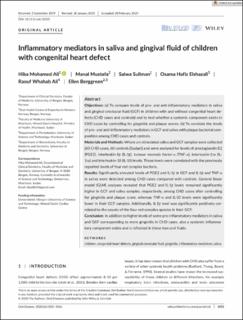Inflammatory mediators in saliva and gingival fluid of children with congenital heart defect
Mohamed Ali, Hiba; Mustafa, Manal; Suliman, Salwa; Elshazali, Osama Hafiz; Ali, Raouf Wahab; Berggreen, Ellen
Journal article, Peer reviewed
Published version

Åpne
Permanent lenke
https://hdl.handle.net/11250/2762343Utgivelsesdato
2020Metadata
Vis full innførselSamlinger
Sammendrag
Objectives
(a) To compare levels of pro- and anti-inflammatory mediators in saliva and gingival crevicular fluid (GCF) in children with and without congenital heart defects (CHD cases and controls) and to test whether a systemic component exists in CHD cases by controlling for gingivitis and plaque scores. (b) To correlate the levels of pro- and anti-inflammatory mediators in GCF and saliva with plaque bacterial composition among CHD cases and controls.
Materials and Methods
Whole un-stimulated saliva and GCF samples were collected (60 CHD cases, 60 controls [Sudan]) and were analysed for levels of prostaglandin E2 (PGE2), interleukin-1β (IL-1β), tumour necrosis factor-α (TNF-α), interleukin-1ra (IL-1ra) and interleukin-10 (IL-10) levels. These levels were correlated with the previously reported levels of four red complex bacteria.
Results
Significantly elevated levels of PGE2 and IL-1β in GCF and IL-1β and TNF-α in saliva were detected among CHD cases compared with controls. General linear model (GLM) analyses revealed that PGE2 and IL-1β levels remained significantly higher in GCF and saliva samples, respectively, among CHD cases after controlling for gingivitis and plaque score, whereas TNF-α and IL-10 levels were significantly lower in their GCF samples. Additionally, IL-1β level was significantly positively correlated to the counts of the four red complex species in their GCF.
Conclusion
In addition to higher levels of some pro-inflammatory mediators in saliva and GCF corresponding to more gingivitis in CHD cases, also a systemic inflammatory component exists and is reflected in these two oral fluids.
